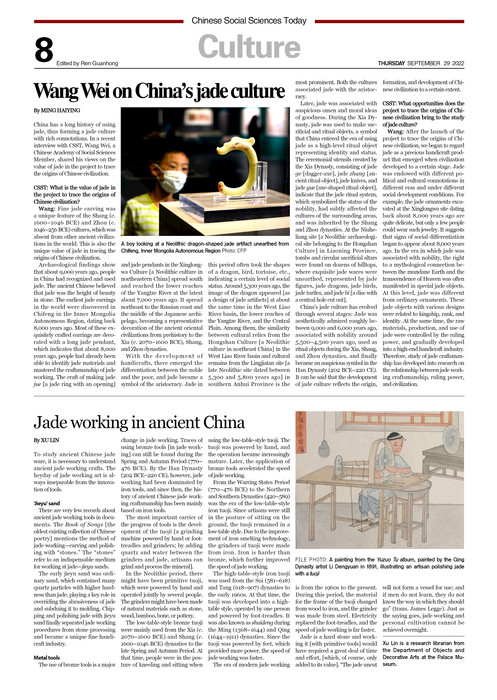Wang Wei on China’s jade culture
2022-09-29 16:36:03
A boy looking at a Neolithic dragon-shaped jade artifact unearthed from Chifeng, Inner Mongolia Autonomous Region Photo: CFP
By MING HAIYING
China has a long history of using jade, thus forming a jade culture with rich connotations. In a recent interview with CSST, Wang Wei, a Chinese Academy of Social Sciences Member, shared his views on the value of jade in the project to trace the origins of Chinese civilization.
CSST: What is the value of jade in the project to trace the origins of Chinese civilization?
Wang: Fine jade carving was a unique feature of the Shang (c. 1600–1046 BCE) and Zhou (c. 1046–256 BCE) cultures, which was absent from other ancient civilizations in the world. This is also the unique value of jade in tracing the origins of Chinese civilization.
Archaeological findings show that about 9,000 years ago, people in China had recognized and used jade. The ancient Chinese believed that jade was the height of beauty in stone. The earliest jade earrings in the world were discovered in Chifeng in the Inner Mongolia Autonomous Region, dating back 8,000 years ago. Most of these exquisitely crafted earrings are decorated with a long jade pendant, which indicates that about 8,000 years ago, people had already been able to identify jade materials and mastered the craftsmanship of jade working. The craft of making jade jue [a jade ring with an opening] and jade pendants in the Xinglongwa Culture [a Neolithic culture in northeastern China] spread south and reached the lower reaches of the Yangtze River at the latest about 7,000 years ago. It spread northeast to the Russian coast and the middle of the Japanese archipelago, becoming a representative decoration of the ancient oriental civilizations from prehistory to the Xia (c. 2070–1600 BCE), Shang, and Zhou dynasties.
With the development of handicrafts, there emerged the differentiation between the noble and the poor, and jade became a symbol of the aristocracy. Jade in this period often took the shapes of a dragon, bird, tortoise, etc., indicating a certain level of social status. Around 5,300 years ago, the image of the dragon appeared [as a design of jade artifacts] at about the same time in the West Liao River basin, the lower reaches of the Yangtze River, and the Central Plain. Among them, the similarity between cultural relics from the Hongshan Culture [a Neolithic culture in northeast China] in the West Liao River basin and cultural remains from the Lingjiatan site [a late Neolithic site dated between 5,300 and 5,800 years ago] in southern Anhui Province is the most prominent. Both the cultures associated jade with the aristocracy.
Later, jade was associated with auspicious omen and moral ideas of goodness. During the Xia Dynasty, jade was used to make sacrificial and ritual objects, a symbol that China entered the era of using jade as a high-level ritual object representing identity and status. The ceremonial utensils created by the Xia Dynasty, consisting of jade ge [dagger-axe], jade zhang [ancient ritual object], jade knives, and jade yue [axe-shaped ritual object], indicate that the jade ritual system, which symbolized the status of the nobility, had subtly affected the cultures of the surrounding areas, and was inherited by the Shang and Zhou dynasties. At the Niuheliang site [a Neolithic archaeological site belonging to the Hongshan Culture] in Liaoning Province, tombs and circular sacrificial altars were found on dozens of hilltops, where exquisite jade wares were unearthed, represented by jade figures, jade dragons, jade birds, jade turtles, and jade bi [a disc with a central hole cut out].
China’s jade culture has evolved through several stages: Jade was aesthetically admired roughly between 9,000 and 6,000 years ago, associated with nobility around 5,500–4,500 years ago, used as ritual objects during the Xia, Shang, and Zhou dynasties, and finally became an auspicious symbol in the Han Dynasty (202 BCE–220 CE). It can be said that the development of jade culture reflects the origin, formation, and development of Chinese civilization to a certain extent.
CSST: What opportunities does the project to trace the origins of Chinese civilization bring to the study of jade culture?
Wang: After the launch of the project to trace the origins of Chinese civilization, we began to regard jade as a precious handicraft product that emerged when civilization developed to a certain stage. Jade was endowed with different political and cultural connotations in different eras and under different social development conditions. For example, the jade ornaments excavated at the Xinglongwa site dating back about 8,000 years ago are quite delicate, but only a few people could wear such jewelry. It suggests that signs of social differentiation began to appear about 8,000 years ago. In the era in which jade was associated with nobility, the right to a mythological connection between the mundane Earth and the transcendence of Heaven was often manifested in special jade objects. At this level, jade was different from ordinary ornaments. These jade objects with various designs were related to kingship, rank, and identity. At the same time, the raw materials, production, and use of jade were controlled by the ruling power, and gradually developed into a high-end handicraft industry. Therefore, study of jade craftsmanship has developed into research on the relationship between jade working craftsmanship, ruling power, and civilization.



